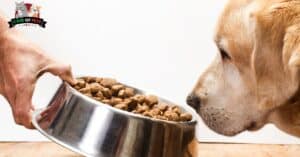Unsure what to fill your furry friend’s food bowl with? You’re not alone! Doggy dietary needs can be just as complex as our own. This guide will become your compass through the exciting (and sometimes overwhelming) world Types of Dog Food.
We’ll sniff out the pros and cons of various food types, from classic kibble to fresh, fridge-ready meals. Whether you have a playful pup with boundless energy or a senior dog with specific health needs, we’ll help you choose the food that perfectly fuels your canine companion’s happy and healthy life. So, grab your leash, and let’s dive into the delicious world of dog food.
What Dry Dog Food Do Veterinarians Recommend?
When it comes to choosing the best dry Dog food, veterinarians emphasize several key factors to consider. These include palatability, a complete and balanced recipe, affordability, and whether the food meets your veterinarian’s approval based on your dog’s nutritional needs. Here are some vet-recommended dry dog foods for different life stages:
- Royal Canin Small Breed Adult Dry Dog Food: This option is tailored for small breeds and provides essential nutrients to keep them healthy1.
- IAMS Adult Minichunks Dry Dog Food: A cost-effective choice that still offers balanced nutrition for adult dogs.
- Hill’s Science Diet Puppy: Specifically formulated for small-breed puppies, this food supports their growth and development.
- Merrick Healthy Grains Large Breed: Ideal for large-breed adults, it includes healthy grains and essential nutrients.
- Purina ONE + Plus Adult Dry Dog Food: Designed to help manage weight while providing complete nutrition.
- Wellness Complete Large Breed Puppy: Supports the unique needs of large-breed puppies during their growth phase.
- Instinct Original Grain-Free Recipe with Real Rabbit: A grain-free option suitable for dogs with sensitive stomachs.
Choosing the right dog food depends on your pet’s requirements, so consult your veterinarian for personalized recommendations. Additionally, consider the Association of Animal Feed Control Officials (AAFCO) statement on the label, which ensures the food meets necessary nutrient standards for your dog’s life stage1. When choosing a diet, your dog’s health and wellbeing should always come first!
The Different Types of Dog Food
There are different types of Dog food. The most popular of them are:
- Vegetarian diet Dog Food
- Wet Dog Food
- Prescription Food for Dog
- Semi-Moist Food
- Fresh Dog Food
- Homemade Dog Food
- Complementary Dog Food
Before we delve into the specifics of each type of Dog food, it’s important to understand that every Dog is unique. One person’s style may not fit another. Age, health conditions, and individual preferences are a few examples of factors that may influence what your feline buddy should eat.
Now, let’s explore the different types of Dog food and their pros and cons.
1. Vegetarian diet Dog Food
Vegetarian dog food is a growing trend among pet owners who want to extend their dietary choices to their canine companions. While dogs are classified as carnivores, they can thrive on a vegetarian diet if it’s carefully formulated to meet their nutritional needs.
Benefits of Vegetarian Dog Food:
- Environmentally Friendly: Meat production has a larger environmental footprint than plant-based protein sources. Choosing vegetarian dog food can help reduce your pet’s carbon pawprint.
- Potential for Allergy Relief: If your dog has allergies to meat protein sources, vegetarian food can be a good alternative to provide them with the nutrients they need.
- Ethical Considerations: Some pet owners choose vegetarian dog food for ethical reasons, aligning their pet’s diet with their own dietary choices.
Disadvantages of Vegetarian Dog Food:
- Nutrient Availability: Certain nutrients like taurine and L-carnitine are more abundant in animal products. Vegetarian dog food needs to be carefully formulated to ensure these essential nutrients are present in sufficient amounts.
- Supplements Might Be Needed: Depending on the brand, some vegetarian dog foods may require additional supplements to meet all your dog’s nutritional needs.
- Long-Term Studies Lacking: While vegetarian dog food appears to be safe for most dogs, long-term studies are still needed to fully understand the impact on canine health.
- Cost: Vegetarian dog food can sometimes be more expensive than traditional meat-based kibble.
Always consult your veterinarian before switching your dog to a vegetarian diet. They can help you choose a food that is appropriate for your dog’s age, breed, and health condition. They can also monitor your dog’s health to ensure they are getting the nutrients they need.
2. Wet Dog Food
Wet dog food is a canned or pouched food that provides a moister alternative to dry kibble. It is typically higher in meat content and moisture than dry dog food, which can be appealing to pickier eaters. Here’s a breakdown of wet dog food:

Benefits of Wet Dog Food:
- Increased Hydration: Wet dog food provides extra moisture, which is important for overall health, especially for senior dogs or those with urinary tract issues.
- More Palatable: The smell and flavor of wet food are often more enticing to dogs than kibble, making it a good option for dogs with finicky appetites.
- Easier to Chew: The softer texture of wet food is easier for dogs with dental problems or those who are missing teeth to chew.
- Nutrient Delivery: Wet food can be a good source of certain nutrients, like vitamins and minerals because the cooking process is gentler than with kibble.
Disadvantages of Wet Dog Food:
- Spoilage: Wet dog food has a shorter shelf life after opening compared to dry kibble.
- Dental Health: Wet food may not promote scraping and chewing as much as dry kibble, which can help clean teeth. Brushing your dog’s teeth regularly is important regardless of diet.
- Cost: Wet dog food is generally more expensive than dry kibble on a per-ounce basis.
- Messy: Wet food can be messier to serve and can stain bowls and floors.
Choosing Wet Dog Food:
- Look for the AAFCO label: Ensure the wet dog food meets the nutritional requirements for dogs as set forth by the Association of American Feed Control Officials (AAFCO).
- Consider your dog’s needs: Choose a food that is appropriate for your dog’s age, breed, and activity level. There are also wet dog foods formulated for specific health conditions.
- Variety is good: Rotate your dog’s protein sources to ensure they get a well-rounded diet.
Consult with your veterinarian before switching your dog’s diet, especially if they have any underlying health conditions.
3. Prescription Food for Dog
Prescription dog food, also called veterinary diets or therapeutic dog food, is specially formulated to address specific health needs in dogs. Unlike regular dog food, you need a prescription from your veterinarian to purchase it. Here’s a closer look at prescription dog food for dogs:

Why Prescription Dog Food?
Vets may recommend prescription dog food for various reasons, including:
- Allergies or Skin Issues: If your dog suffers from food allergies or skin sensitivities, a prescription food with limited ingredients or novel protein sources can help manage symptoms.
- Digestive Problems: For dogs with digestive issues like diarrhea or vomiting, a prescription food with easily digestible ingredients or probiotics can aid recovery.
- Kidney or Liver Disease: Prescription food can be formulated to manage specific needs like reduced protein content for kidney disease or to support liver function.
- Weight Management: Veterinary weight management diets can help obese or overweight dogs lose weight safely.
- Dental Health: Prescription dental diets can promote oral health by reducing plaque and tartar buildup.
Benefits of Prescription Dog Food:
- Tailored Nutrition: Prescription diets are specifically formulated to address specific health conditions or dietary needs. Whether your dog has allergies, kidney disease, weight management issues, or gastrointestinal problems, prescription food can provide targeted nutrition to support their well-being.
- Controlled Ingredients: These diets often contain carefully selected ingredients to minimize potential allergens or irritants. For example, hypoallergenic diets avoid common allergens like beef, chicken, or grains. This controlled approach helps manage food sensitivities.
- Support for Medical Conditions:
- Urinary Health: Prescription diets can prevent urinary stones by adjusting mineral levels and pH balance.
- Joint Health: Some formulas include supplements like glucosamine and chondroitin to support joint health.
- Digestive Health: Sensitive stomachs benefit from easily digestible proteins and limited ingredients.
- Weight Management: Prescription weight loss diets help dogs shed excess pounds safely.
- Veterinarian Guidance: Prescription diets are recommended by veterinarians based on your dog’s specific needs. Regular check-ups allow adjustments as necessary.
Disadvantages of Prescription Dog Food:
- Cost: Prescription diets tend to be more expensive than regular commercial dog food. The specialized ingredients and quality control contribute to the higher price.
- Limited Variety: Prescription foods come in limited flavors and formulations. While this consistency is essential for managing health conditions, it may be less exciting for your dog.
- Transition Challenges: Switching to prescription food can be tricky. Some dogs resist the change due to taste differences or texture. Gradual transitions are crucial.
- Strict Adherence: To see the desired results, strict adherence to the prescribed diet is necessary. Any deviations may impact your dog’s health.
Prescription dog food serves a specific purpose, and it’s essential to consult your veterinarian before making any dietary changes. They can guide you on the best options for your furry friend’s health!
4. Semi-Moist Food
Semi-moist dog food offers a texture that falls between dry kibble and wet food. It’s softer and chewier than kibble, but not as soupy as canned food. Here’s a breakdown of the pros and cons of semi-moist dog food.

Benefits of Semi-Moist Dog Food:
- Ease of Chewing: Semi-moist dog food is easier to chew compared to dry kibble. This makes it a suitable choice for older dogs, picky eaters, and those with dental problems.
- Palatability: Many dogs find semi-moist food more appealing due to its softer texture and higher moisture content. This can be especially helpful if your dog is a finicky eater.
- Convenience: Semi-moist food strikes a balance between dry kibble and wet canned food. It doesn’t require rehydration like dehydrated food and doesn’t come in large cans. Portioning is straightforward, making it convenient for pet owners.
Disadvantages of Semi-Moist Dog Food:
- Cost: Semi-moist dog food tends to be more expensive per ounce than dry kibble. If budget is a concern, this may impact your decision.
- Preservatives and Ingredients: Semi-moist food contains preservatives to maintain its texture and shelf life. Additionally, some brands may include unnecessary ingredients that could be harmful to dogs. Always check the ingredient list carefully.
- Moisture Content: While semi-moist food has a higher moisture content than dry kibble, it still falls short of the moisture levels in wet canned food. If your dog requires more hydration, consider other options.
Choosing Semi-Moist Dog Food:
- AAFCO Label: Ensure the food meets the nutritional requirements for dogs as set forth by the Association of American Feed Control Officials (AAFCO).
- Ingredient Quality: Prioritize whole food ingredients like meat, vegetables, and whole grains. Avoid foods high in artificial additives or simple carbohydrates.
- Your Dog’s Needs: Consider your dog’s age, breed, and activity level.
Before switching your dog to semi-moist food, consult your veterinarian. They can help you determine if this type of food is suitable for your dog’s specific needs and health conditions. They can also advise you on choosing a high-quality semi-moist food that provides your dog with the right balance of nutrients.
5. Fresh Dog Food
Fresh dog food has become increasingly popular among pet owners seeking a more natural and potentially healthier diet for their furry companions. Fresh dog food is formulated with whole food ingredients like meat, poultry, vegetables, and fruits, similar to what you might prepare at home for yourself. Unlike kibble which is cooked at high temperatures, fresh food is minimally processed and typically refrigerated or frozen until feeding.
Benefits of Fresh Dog Food:
- Potentially Higher Nutrient Content: Minimal processing may help retain more vitamins, minerals, and natural enzymes than kibble.
- Increased Hydration: Fresh food has a higher moisture content than kibble, which can be beneficial for overall health, especially for senior dogs or those with urinary tract issues.
- More Palatable: The fresh ingredients and aroma can be more enticing to picky eaters.
Disadvantages of Fresh Dog Food:
- Cost: Fresh dog food is generally more expensive than dry kibble.
- Storage and Convenience: Fresh food requires refrigeration or freezing and meal prep, which can be less convenient than kibble.
- Balanced Nutrition: It’s crucial to ensure the fresh food you choose is formulated by a veterinary nutritionist or meets AAFCO standards to guarantee it provides all the essential nutrients your dog needs.
- Spoilage: Fresh food has a shorter shelf life after opening than kibble.
Fresh dog food can be a healthy option for some dogs, but it’s important to weigh the pros and cons and discuss it with your veterinarian to ensure it’s the right choice for your pet.
6. Homemade Dog Food
Homemade dog food offers pet owners the chance to provide their furry companions with a diet they have complete control over. Let’s explore the advantages and disadvantages to help you decide if it’s the right choice for you and your dog.

Benefits of Homemade Dog Food:
- Better Nutrition: Homemade food is often fresher and includes more whole foods, giving your dog better nourishment1.
- Customization: You can tailor the ingredients to your dog’s specific needs and preferences. This is especially helpful for dogs with allergies, sensitivities, or weight management goals.
- Freshness: Homemade food uses fresh ingredients, potentially delivering more vitamins, minerals, and natural enzymes than processed kibble.
- Bonding Experience: Preparing your dog’s food can be a fun and rewarding way to show them you care. It allows you to connect with your pet and ensure they’re getting high-quality ingredients.
Disadvantages of Homemade Dog Food:
- Nutritional Balancing: Creating a balanced homemade diet that meets all your dog’s nutritional needs requires significant effort. A deficiency in any essential nutrients can lead to health problems. Seeking advice from a veterinary nutritionist is strongly advised.
- Time Commitment: Planning, prepping, and cooking meals take time and effort, especially for busy lifestyles. Consistency is key, so be prepared for the ongoing commitment.
- Food Safety: Raw ingredients like meat and eggs can harbor bacteria. Improper handling can lead to foodborne illnesses in both you and your dog. It is imperative to adhere to proper food handling procedures.
Homemade dog food can be a healthy option for some dogs, but it requires significant research, planning, and effort. Discuss it with your veterinarian to ensure it meets your dog’s needs and is safe for them to consume.
7. Complementary Dog Food
Complementary dog food is a recently emerged trend that allows pet owners to add variety and potentially enhance their dog’s diet alongside their primary food source. It’s distinct from complete dog food (kibble, wet food) as it’s not formulated to meet all a dog’s nutritional needs on its own.

Benefits of Complementary Dog Food:
- Increased Hydration: Fresh toppers and bone broth can add moisture, especially beneficial for senior dogs or those with urinary tract issues.
- Variety and Enrichment: Complementary food adds excitement to mealtime, potentially reducing picky eating and boredom.
- Targeted Nutrition Boost: Specific toppers or freeze-dried raw options can provide additional nutrients to support your dog’s health, like glucosamine for joints or probiotics for digestion.
Disadvantages of Complementary Dog Food:
- Incomplete Nutrition: Complementary foods lack the essential nutrients required for a balanced diet. Relying solely on complementary foods can lead to deficiencies over time.
- Portion Control and Overfeeding: Pet owners may unintentionally overfeed when using complementary foods alongside regular meals. It’s essential to adjust portion sizes accordingly to avoid weight gain.
- Quality and Ingredients: Not all complementary foods are created equal. Some may contain low-quality ingredients or unnecessary additives. Select reliable brands at all times, and carefully study labels.
Types of Complementary Dog Food:
- Fresh Toppers: Fresh, human-grade ingredients like chopped vegetables, fruits, cooked lean meats, or yogurt can be added to kibble to boost moisture, and palatability, and provide additional vitamins or fiber.
- Freeze-Dried Raw: These are minimally processed, dehydrated raw meat chunks or whole meals that can be rehydrated with water for a more natural, nutrient-dense option.
- Bone Broth: Bone broth is simmered bones and joints, resulting in a flavorful liquid rich in collagen, glucosamine, and other nutrients that support joint health and hydration.
Complementary dog food can be a great way to add variety and potentially enhance your dog’s diet, but it should never replace their primary food source. Always consult your veterinarian for guidance on incorporating complementary food safely and effectively into your dog’s meal plan.
For More Information
We have a ton of information regarding what foods, from popular snacks to fruits, are healthy or harmful for your dog. You might also be interested in “Can Dog Eat Corn?“
Conclusion
Your dog’s health and lifespan can be greatly impacted by the sort of food they eat. There are benefits and drawbacks to homemade, wet, and dry dog food. Although it is more practical and beneficial to tooth health, dry food is less moisturizing than wet food. However, because it contains a significant amount of moisture, wet food can help avoid kidney disease, even though it might not be a full diet.
Customized diets designed under the guidance of a veterinary nutritionist can address certain medical conditions and dietary needs. But to make sure you get all the vitamins and minerals you need, they need to be prepared carefully.
Keep in mind that your feline friend’s age, health, and preferences will determine the finest kind of dog food for them. To make sure that your dog’s nutritional needs are satisfied, always review the contents list and speak with your veterinarian. For your dog’s general health and pleasure, a balanced diet is essential, regardless of whether you feed them homemade, wet, or dry food.













